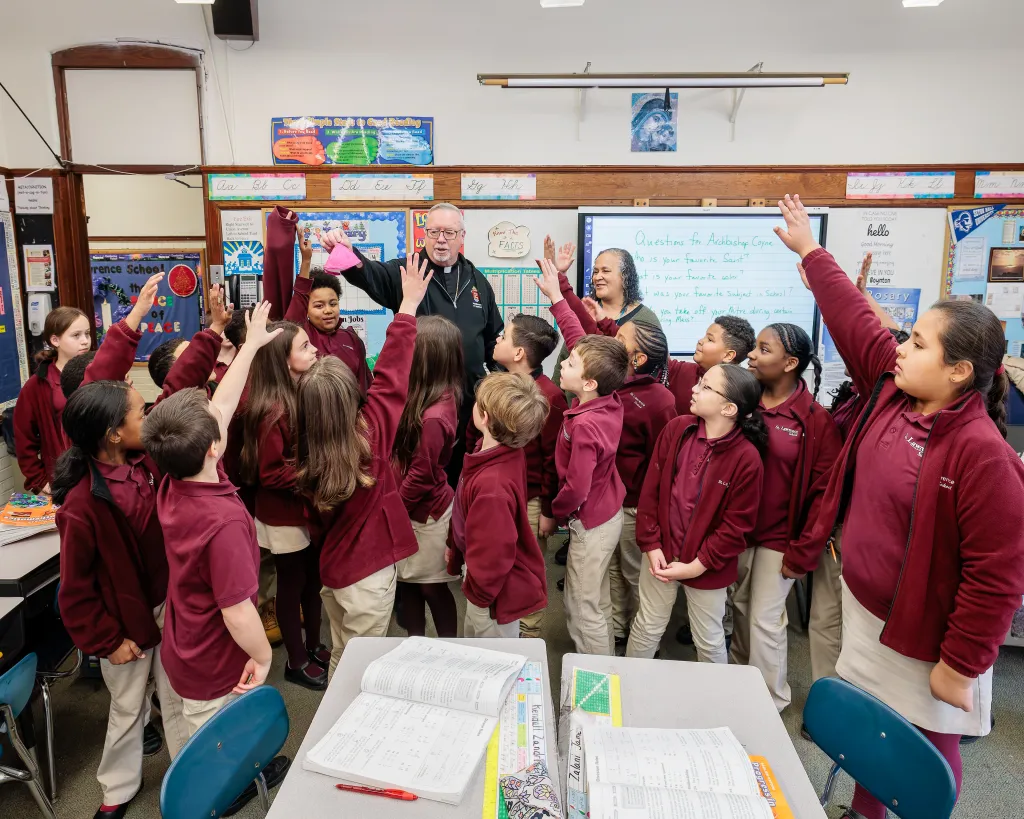
Hartford is an outlier in the state as the only city in Hartford, New Haven and Litchfield counties that does not have an Archdiocese Catholic school.
That will change in the fall of 2026 with the opening of the Catholic Academy of Hartford, the first Archdiocese Catholic school in the city since 2016 when St. Augustine school closed.
Since becoming Hartford’s archbishop in 2024, Archbishop Christopher Coyne has advocated to bring Catholic education back to the city.
The school located at 765 Asylum Ave. will begin as a pre-kindergarten through second-grade institution, adding a grade level each year and ultimately offering pre-kindergarten through eighth grade, according to the Archdiocese of Hartford.
The Archdiocese purchased the building for $1.5 million, Coyne said.
“We are not only opening the school but we are committing ourselves to being there and doing what we can to revive the neighborhood by cleaning up the school and working with the Asylum Hill community to make that part of the city more livable and sustainable,” said Coyne in an interview with the Courant.
Coyne added that the Archdiocese was also working toward producing affordable housing in the area for residents.
Change in demographics
The number of Catholic schools plummeted in the area due to change in demographics, finances and the closure of churches with the Catholic community shrinking in the city, Coyne said.
“The sad reality is that over time before I arrived two years ago, many of the parish schools and other Catholic schools did not have the numbers to sustain the schools as the number of children being born and the number of inner city parishes declined as people moved outward,” Coyne said.
Daniel Rober, associate professor and chair in the department of catholic studies at Sacred Heart University, said in the city of Hartford the Catholic population moved to more suburban environments.
“The traditional Catholic school model was based on the Catholic parish model,” Rober said, explaining that each parish school was located next to a parish church. Nuns and religious brothers taught students and most students could afford to attend the schools as the faculty was paid very little, he said.
“The Catholics moved out and the schools closed and now what you are seeing in all areas is these kinds of different models of Catholic education emerging,” he said.
There are now three different models of Catholic education, Rober said.
“Now you tend to have more regional Catholic academies which continue the legacy of the parish schools in a more concentrated way sponsored by the archdiocese,” he said. “The second model is a classical model, which tends to be lay-led, highly intentional and again somewhat conservative in its educational style. The third is a charter or magnet or social justice model which tends to be located in an inner city or poorer environment where students would not have access to private or Catholic education and involves letting families pay as they can.”
Coyne said the school plans to operate a “just tuition model,” which is based on the family’s ability to pay.
“We want to make sure that cost is not a barrier to any child coming to our school aside from making it completely tuition free, which is not workable although it is the vision that I have,” Coyne said. ”We have asked families to pay what they can.”
Coyne added: “The myth is that Catholic schools serve a middle, upper middle class student body. We serve students where they are.”
“Good human beings”
The Catholic Academy of Hartford will join 39 other schools in the state beginning in the fall of 2026. It will be the second new Catholic school to open in the state next fall. The Archdiocese also plans to open another school in New Britain.
Coyne said Catholic schools don’t just educate the child, “we form them to be good human beings, to be ethical human beings and to be good citizens and giving them the opportunity to thrive as adults.”
He said school enrollment is thriving at the schools with waiting lists at all of the schools.
Valerie Mara, superintendent of Catholic schools in the Archdiocese of Hartford, said enrollment slowly increased since COVID at Catholic schools.
“I believe what happened is because our doors were open, many families who couldn’t afford to stay at home with their children enrolled their children in our schools,” she said.
Academic achievement
Mara said students in Catholic schools on average far exceed national and state averages on test scores.
“The Class of 2025 SAT results far exceeded the state of Connecticut for certain averages,” Mara said. “When we look at our elementary school NAEP math assessment our eighth graders scored well into the 85th and 90th percentile.
“So much of it is because our curriculum is formed on basic skills,” Mara said. “There is literacy across every content area. There is writing across every content area and our teachers embody the philosophy of teaching the whole child: mind, body and spirit. Our students need to create creatively and imaginatively.”
Mara said it is integral to teach the whole child and that students are taught that everyday is the chance to begin again and take any mistakes or faults as an opportunity to grow. She said spirituality is a central part of teaching in the schools.
There are an estimated 9,000 students enrolled in the Catholic schools, Mara said.
Mara said she is proud that teachers know the names of every one of their students.